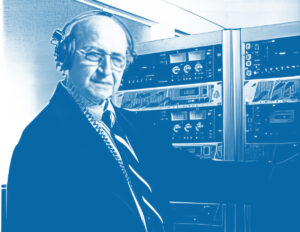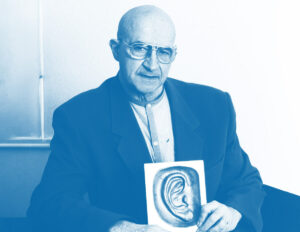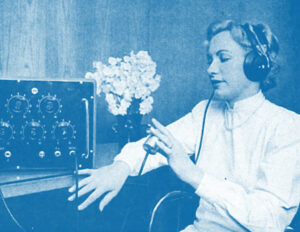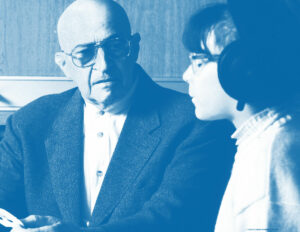Alfred Tomatis
the Pioneer
Alfred Tomatis was a great French otolaryngologist and inventor who pioneered the interdisciplinary field, of “audio-psycho-phonology”. He is known for developing the Tomatis® Method, a sound-based therapy to improve communication and learning abilities through auditory stimulation. Alfred Tomatis developed the theory that many vocal problems were really hearing problems. His theory that 'the voice does not produce what the ear does not hear', is the hallmark of his research and his Method.
Who is Alfred Tomatis?
Alfred Tomatis, a visionary Medical Doctor (ENT) and the founder of the revered Tomatis® Method whose life’s work revolutionised the way we communicate with ourselves and others. Driven by a relentless passion for understanding the intricate connection between the voice, the brain, and the ear, Tomatis emerged as a true pioneer in the realm of cognitive science. Today, the fruits of his labour continue to flourish, as recent research on brain plasticity illuminates the extent of his legacy. In the book “The Brain’s Way of Healing,” renowned neurologist Norman Doidge pays tribute to Tomatis, solidifying his significance in science and medicine. Through his extraordinary journey, Tomatis unveiled the transformative power of sound on the human mind, proving how one person’s passion can shape history’s course.
Alfred Tomatis : History
Alfred Tomatis, born in France to a musical family, became an ENT doctor with a passion for treating ear, nose, and throat disorders. He developed the theory that vocal problems were often related to hearing problems, laying the foundation for his research and the Tomatis® Method.

Tomatis invented the Electronic Ear sound system and submitted his "Tomatis® laws" that established the link between hearing, phonation, listening, and communication. The Method gained recognition, especially for singers.

The Tomatis® Method expanded to address emotional disorders, learning difficulties, language problems and foreign language learning. The Electronic Ear sound system further improved its efficacy with personalized parameters.

An era of tech advancements - new technologies, including bone conduction headsets and the Tomatis® Listening Test System, further enhanced the program’s precision. Books like "The Ear and the Voice" were published, gaining recognition and centers opened worldwide.

The Method continued to develop with new parameters and applications. Digital filters improved the Electronic Ear system, standardizing the Method's procedures globally.

Transitioning to the tech era. The Electronic Ear became Tomatis® Audio Pro, offering improved sound quality and precision. After Alfred Tomatis retired, his son Christian and Thierry Gaujarengues continued his legacy.

The listening test system was perfected, and the portable Solisten® device was introduced for home listening sessions.
The Tomatis® Method became more accessible, efficient and mobile from 2011 with the introduction of TalksUp®.

Since 2017, the Tomatis® Method has become even more accessible with the introduction of the Tomatis® Academy online training platform and the personal Tomatis® Infinite headphones.
The Tomatis® Bone Conduction Kit is created for sensitive users, to replace headphones initially, especially for babies, children under 2.

Riding the wave of technological advancements, efforts have centered around miniaturizing and refining processes to consolidate all Tomatis® technology into a single device. Embracing the digital age has led to the creation of a digital services platform designed to facilitate client programs and assess clients, ultimately aiming to simplify the Tomatis® experience for practitioners. Step into the cutting-edge suite of Tomatis® tools, crafted to be the most advanced in the field.
The Tomatis® Method continues to transform lives, one step at a time. The question remains: will you join us to write the future of the Tomatis® Method?

Alfred Tomatis, born in France to a musical family, became an ENT doctor with a passion for treating ear, nose, and throat disorders. He developed the theory that vocal problems were often related to hearing problems, laying the foundation for his research and the Tomatis® Method.

Tomatis invented the Electronic Ear sound system and submitted his "Tomatis® laws" that established the link between hearing, phonation, listening, and communication. The Method gained recognition, especially for singers.

The Tomatis® Method expanded to address emotional disorders, learning difficulties, language problems and foreign language learning. The Electronic Ear sound system further improved its efficacy with personalized parameters.

An era of tech advancements - new technologies, including bone conduction headsets and the Tomatis® Listening Test System, further enhanced the program’s precision. Books like "The Ear and the Voice" were published, gaining recognition and centers opened worldwide.

The Method continued to develop with new parameters and applications. Digital filters improved the Electronic Ear system, standardizing the Method's procedures globally.

Transitioning to the tech era. The Electronic Ear became Tomatis® Audio Pro, offering improved sound quality and precision. After Alfred Tomatis retired, his son Christian and Thierry Gaujarengues continued his legacy.

The listening test system was perfected, and the portable Solisten® device was introduced for home listening sessions.
The Tomatis® Method became more accessible, efficient and mobile from 2011 with the introduction of TalksUp®.

Since 2017, the Tomatis® Method has become even more accessible with the introduction of the Tomatis® Academy online training platform and the personal Tomatis® Infinite headphones.
The Tomatis® Bone Conduction Kit is created for sensitive users, to replace headphones initially, especially for babies, children under 2.

Riding the wave of technological advancements, efforts have centered around miniaturizing and refining processes to consolidate all Tomatis® technology into a single device. Embracing the digital age has led to the creation of a digital services platform designed to facilitate client programs and assess clients, ultimately aiming to simplify the Tomatis® experience for practitioners. Step into the cutting-edge suite of Tomatis® tools, crafted to be the most advanced in the field.
The Tomatis® Method continues to transform lives, one step at a time. The question remains: will you join us to write the future of the Tomatis® Method?

The Family Background
1920 - 1950
Born in Nice in 1920, Alfred Tomatis, a French ENT Medical specialist, researcher, and creator of the renowned Tomatis Method, left an indelible mark on our understanding of the ear and its implications in motor, emotional, and cognitive disorders.
Tomatis’ upbringing in a family of singers shaped his destiny. Surrounded by the melodic world of opera, his grandfather and father, Humbert Dante Tomatis, renowned opera performers, influenced his early years. Sent to Paris at age 11, he underwent a transformative journey from a rebellious child to a diligent scholar, recognizing his calling to become a doctor. Tomatis’ family connections led to a clientele predominantly composed of singers and friends of his father, many of whom suffered from vocal issues and sought his expertise.
His close interaction with this particular clientele steered his focus towards exploring the intricacies of the human ear and its impact on various aspects of human function, resulting in groundbreaking work that would go on to revolutionise our understanding of auditory health and beyond.
The birth of the Electronic Ear and the Tomatis® Effect [Laws]
1950 - 1955
During his early career, Alfred Tomatis began as an intern at Bichat’s hospital in Paris and later moved to Bretonneau’s hospital. The ravages of war confronted the young doctor when Paris was bombed in 1943. After the war, he took charge of the acoustic labs at aeronautical arsenals, where he examined the hearing of employees exposed to the daily clamour of engine planes, leading to work-related deafness. Fascinatingly, Tomatis discovered a consistent correlation between the alterations in their ears and vocal deficiencies. Drawing parallels between audiometric profiles of workers and singers, he noticed that singers, when pushing their voices to the extreme, reached decibel levels equivalent to a jet engine. This revelation indicated that singers had inadvertently harmed their voices by damaging their hearing, revealing the existence of an audio-vocal loop, where “the voice only contains what the ear can hear.”
In his insightful observations, Alfred Tomatis distinguished between hearing and listening. While hearing refers to the passive reception of sound, listening involves actively selecting sensory information to make sense of the world. With his innovative approach, he devised a groundbreaking device, the “Electronic Ear” or “Electronic Gating”, capable of rehabilitating listening through a system of sound. This invention marked a pivotal moment in his career, setting the stage for further advancements in the understanding and treatment of auditory and vocal challenges.
In his keen observation, Alfred identified the existence of an audio-vocal loop, underscoring the profound link between the ear and the voice — revealing the “Tomatis® Laws” that were submitted to the Academy of Sciences in Paris in 1957. These laws established that:
- The voice only contains what the ear can hear
- If listening is modified, the voice is instantly and unconsciously modified too
- It is possible to transform the voice permanently through sound stimulation conducted for a determined period (law of remanence)
Conception of the Tomatis Method
1955 - 1960
In 1958, Alfred Tomatis introduced the world to the first Electronic Ear at the Universal Exhibition in Brussels, a groundbreaking innovation that garnered him the prestigious Gold Medal for his exceptional scientific research.
Beyond his professional achievements, Alfred was also a devoted father to five children. Among them, his son Christian pursued law and psychology and actively joined the family business, contributing to his father’s research endeavors.
Throughout his career, Alfred Tomatis continued to delve into research, collaborating with various universities in South Africa and Canada. During this period, he made remarkable discoveries linking the ear to posture, balance, and muscular tone. He formulated hypotheses on auditory laterality and the concept of a dominant ear, shedding light on how these factors influence human perception and function.
Alfred also discovers that the foetus begins to hear as early as the eighteenth week of pregnancy, attributing a significant role to the ear in cognitive development. Notably, he emphasized the critical importance of intra-uterine listening in emotional development. These profound connections between Otorhinolaryngology and psychology paved the way for a new interdisciplinary field, which Alfred named “audio-psycho-phonology,” establishing a profound and lasting impact on our understanding of the human mind and its intricate connections to the auditory system.
Alfred Tomatis' Legacy : Research and Books
1960 - 2000
Alfred’s research and clinical trials broadened the application of his Method to various areas such as attention, learning, voice and language, emotional control, motor skills & coordination, and Autism Spectrum disorders. He found remarkable success in assisting autistic children, kids with attention and speech issues. His Method transformed lives, benefiting both individuals and those around them. To achieve this, he expanded his team with talented professionals and collaborated with the French pediatrician and psychoanalyst Françoise Dolto. His Paris centre on Avenue de Courcelles was meticulously organized to cater to a diverse international clientele.
Tomatis attracted various personalities seeking his expertise. Among them were Maria Callas, who believed her voice was connected to her ear, and Gerard Depardieu, who found solace in the Tomatis® Method for language difficulties. Gerard later delivered a moving testimony on his debut and his experience with the Tomatis® Method.
Alfred Tomatis wrote 14 books, including the highly successful The Ear and Language (1963), The Ear and Life (1977), The Ear and Voice (1987), School Troubles (1988), Nine Months in Paradise (1989), Why Mozart? (1991). These books reflect the will of Alfred Tomatis to make his approach understandable and to speak directly to a wide audience.
Both controversy and admiration marked Dr. Tomatis’ career. He faced criticism in an era when brain understanding was nascent but was admired for his determination to change lives, following his instincts, and defending his ideas. Eventually, weary of constant criticism, he resigned from the Conseil de l’Ordre des médecins in 1974 and was permanently removed.
The Tomatis® Method found its greatest reception abroad, with centers established worldwide [mainly in Europe, Canada, the USA, South Africa, and Japan], thanks to Alfred Tomatis’ efforts in presenting it. He safeguarded the Method’s integrity and intellectual protection.
To represent his organization, Tomatis enlisted the help of his friend, painter, and sculptor Edgard Pillet to design the brand logo. The logo’s artistry captured the ear’s essential role in listening and its resemblance to the foetus’s form, a profound symbol of its significance in a baby’s development in the womb. This iconic logo now represents the Tomatis® Method in over seventy-five countries.
Technological Transformation
2000 - 2023
Alfred Tomatis passed away in December 2001, but his intellectual legacy remains protected by his son – Christian Tomatis and Thierry Gaujarengues. They have tirelessly worked to make the Method more accessible, innovative, and effective.
Between 2000 and 2010, the Tomatis® Method experienced significant technological improvements. The shift from analog to digital technology from 2000 to 2005 enhanced the sound quality and accuracy of the equipment, leading to the development of the Electronic Ear, which was later renamed Tomatis® Audio Pro. In the subsequent years, up to 2010, improvements were made to the Electronic Ear’s listening test system, expanding its calibration frequencies from 11 to 35. This allowed professionals to gain a deeper understanding of their clients’ listening profiles. The miniaturization of the Electronic Ear’s components resulted in the creation of Solisten®, a compact device designed for conducting listening sessions at home.
During this time, the Tomatis® Method saw an increase in its adoption in educational settings, with 220 schools across Europe, both public and private, integrating the method with the support of European Union funding. Additionally, this era introduced TalksUp®, a further miniaturized version of the Electronic Ear, tailored for the real-time processing of music and voice, and versatile enough to be adjusted for various training levels. Tomatis® Infinite marked a groundbreaking milestone by integrating personalized headphones with dedicated Tomatis® programming, setting a new precedent in the method.
The Digital Shift
2023 - Present
All of that paved the way for creating a new headphone – a comprehensive, all-in-one solution embodying the full spectrum of Tomatis® Technology and a digital services platform that functions as a working station for practitioners to assess clients’ listening profiles and design full Tomatis programs.
Tomatis’ discoveries on the ear and sound stimulation have left a lasting impact on neurosensory stimulation. His pioneering work on brain plasticity and neuroscience inspired many, leading to posthumous scientific recognition. Today, the Tomatis® Method has proven effective in areas related to behaviour, emotions, language, and voice and enhancing brain plasticity. Renowned neurologist Norman Doidge acknowledged Tomatis as a pioneer in his book “The Brain’s Way of Healing.”
Under the leadership of Thierry Gaujarengues and with the addition of Grégoire Tomatis, Alfred’s grandson, the company has seen remarkable progress in technological innovation, global expansion, and the number of professionals trained in the Method’s application. Over 200,000 people from five continents benefit from the Tomatis® Method each year, a testament to its effectiveness and influence worldwide. Alfred Tomatis’ legacy continues to thrive, positively impacting the lives of countless individuals.



